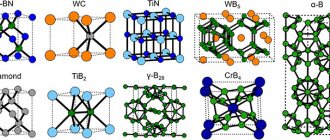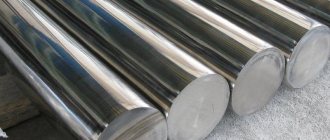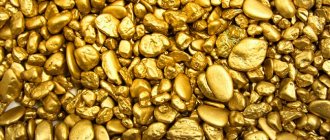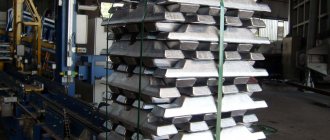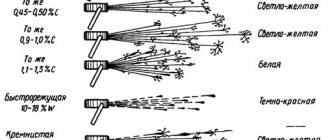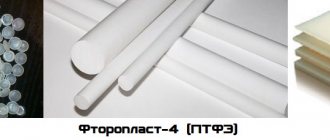White gold is an alloy of gold. It is made by mixing pure gold with silvery-white metals such as silver and palladium. It was originally designed to imitate platinum, a precious white metal.
In the industry, the term "white gold" is often used to describe karat gold alloys with a whitish tint. The word "white" refers to a wide range of colors that overlap with pale yellow, pale pink and brown.
The characteristics of white gold depend on the metal alloys and their proportions. Therefore, white gold alloys can have several different uses.
Density tables for metals and alloys
All metals have certain physical and mechanical properties, which, in fact, determine their specific gravity.
To determine how suitable a particular alloy of ferrous or stainless steel is for production, the specific gravity of rolled metal is calculated. All metal products that have the same volume, but are made from different metals, for example, iron, brass or aluminum, have different mass, which is directly dependent on its volume. In other words, the ratio of the volume of the alloy to its mass—specific density (kg/m3)—is a constant value that will be characteristic of a given substance. The density of the alloy is calculated using a special formula and is directly related to the calculation of the specific gravity of the metal. The specific gravity of a metal is the ratio of the weight of a homogeneous body of this substance to the volume of the metal, i.e. this is density, in reference books it is measured in kg/m3 or g/cm3. From here you can calculate the formula for finding out the weight of a metal. To find this you need to multiply the reference density value by the volume.
The table shows the densities of non-ferrous metals and ferrous iron. The table is divided into groups of metals and alloys, where under each name the grade according to GOST and the corresponding density in g/cm3 are indicated, depending on the melting point. To determine the physical value of specific density in kg/m3, you need to multiply the tabulated value in g/cm3 by 1000. For example, this way you can find out what the density of iron is - 7850 kg/m3.
The most typical ferrous metal is iron. The density value of 7.85 g/cm3 can be considered the specific gravity of iron-based ferrous metal. Ferrous metals in the table include iron, manganese, titanium, nickel, chromium, vanadium, tungsten, molybdenum, and ferrous alloys based on them, for example, stainless steel (density 7.7-8.0 g/cm3), black steel ( density 7.85 g/cm3) is mainly used by manufacturers of metal structures in Ukraine, cast iron (density 7.0-7.3 g/cm3). The remaining metals are considered non-ferrous, as well as alloys based on them. Non-ferrous metals in the table include the following types:
− noble metals (precious) - platinum, gold, silver and semi-precious copper;
− low-melting metals – zinc, tin, lead.
Other types of colored gold
Pure gold is a soft, slightly reddish-yellow metal. However, when alloyed with harder metals, it produces a range of colors including yellow, red, green, purple, blue and black.
Yellow Gold: Has a unique warm glow. It is considered more traditional than white gold. Unlike white gold and platinum, which look the same, yellow gold is difficult to imitate.
It is usually alloyed with copper and silver. Most 18k yellow gold items contain 75% gold, 12.5% copper and 12.5% silver. A darker yellow color is achieved by increasing the amount of copper to 15%.
Rose Gold and Red Gold: Seem similar, but the difference lies in the copper content. The higher the concentration of copper in the alloy, the darker the red color. Red gold contains the most copper, while rose gold contains the least. Sometimes zinc is added to the alloy to give it a reddish-yellow color.
18K rose gold contains 75% gold, 20% copper and 5% silver; 18K rose gold has the same amount of gold with 22% copper, 4% silver; and 18K red gold contains 25% copper and no silver. 12K red gold contains gold and copper in equal proportions.
Blue gold: is an intermetallic compound obtained by mixing gold with indium or gallium. The first contains 54% indium and 46% gold, and the second contains 59% gold and 41% gallium.
Purple Gold: is an alloy of gold (79%) and aluminum (21%). These intermetallic compounds are quite rare and more brittle than most gold alloys.
Black gold: obtained through various surface treatment methods. Gold alloys with a high copper content can be dyed a variety of colors from black to brown by treating them with potassium sulfide.
Black gold can also be produced by controlled oxidation of gold alloys containing cobalt or chromium, or by creating nanostructures on the surface using a femtosecond laser.
Gray Gold: Typically produced by mixing gold (75-76%) with palladium (15-23%) and rhodium (1-5%). 18K gray gold can also be produced without bleaching elements such as palladium, nickel and cobalt - this inexpensive alternative includes 75-78% gold, 7-15% manganese, 1-10% silver and 1-2% copper.
Green Gold: Made by adding 4% cadmium. Its use is generally reduced because cadmium is toxic.
Specific gravity of non-ferrous metals
Table. Specific gravity of metals, properties, metal designations, melting point
When rolling non-ferrous metal blanks, it is also necessary to know exactly their chemical composition, since their physical properties depend on it. For example, if aluminum contains impurities (even within 1%) of silicon or iron, then the plastic characteristics of such a metal will be much worse. Another requirement for hot rolling of non-ferrous metals is extremely precise temperature control of the metal. For example, zinc requires a temperature of strictly 180 degrees when rolling - if it is slightly higher or slightly lower, the capricious metal will sharply lose its ductility. Copper is more “loyal” to temperature (it can be rolled at 850 - 900 degrees), but it requires that the melting furnace must have an oxidizing (with a high oxygen content) atmosphere - otherwise it becomes brittle.
Table of specific gravity of metal alloys
The specific gravity of metals is most often determined in laboratory conditions, but in their pure form they are very rarely used in construction. Alloys of non-ferrous metals and alloys of ferrous metals, which according to their specific gravity are divided into light and heavy, are much more often used.
Light alloys are actively used by modern industry due to their high strength and good high-temperature mechanical properties. The main metals of such alloys are titanium, aluminum, magnesium and beryllium. But alloys based on magnesium and aluminum cannot be used in aggressive environments and at high temperatures.
Why is gold alloyed with other metals?
Because pure gold is a very soft and malleable metal, it is alloyed with a mixture of metals to increase strength and durability for use in jewelry. In fact, the gold you see in any industry is rarely pure. Some impurities (such as mercury) are added before alloying to produce white gold. Without harder alloys, pure gold would not be able to maintain its desired shape—gold itself would be too soft.
18k white gold chain
Some white gold jewelry is additionally plated with rhodium, a rare silvery-white metal. It enhances the shine and durability of jewelry, giving it smoothness and shine.
Specific gravity and specific gravity of copper
Of the non-ferrous metals in their pure form, only aluminum and copper are used in construction work and industry. They have excellent characteristics suitable for the typical type of work. However, alloys based on these materials are becoming increasingly popular. One of the alloys of copper is brass. Brass is a multi-component or consisting of only two components copper-based alloy, in which the main element is the alloying component - zinc and additive components such as nickel, tin, manganese, lead, iron and others are rarely used.
What is white gold made of?
White gold is composed primarily of gold and a mixture of dense metals such as copper, zinc, nickel, rhodium or palladium. The white color is achieved by carefully selecting alloying metals that bleach the reddish-yellow color of pure gold.
The amount of gold is measured in a unit called karats (K). In 24 karat gold, all 24 parts of gold are pure gold with extremely low levels of impurities.
Similarly, 18k gold contains 75% (or 18/24) gold, while 22k gold is 91.6%.
The proportion of alloy added affects the overall durability and final color of the gold. For example, 22 karat gold is stronger and has a more yellowish tint than 18 karat gold.
As a rule, white gold is marked as 18 carats. It contains 75% gold and approximately 25% nickel and zinc. Some types of white gold contain 90% gold and 9.5% nickel. To increase ductility, a small amount of copper is added to it.
White gold used in the jewelry industry is an alloy of gold-nickel-copper-zinc or gold-palladium-silver. Nickel and palladium act as primary bleaching agents to reduce the color of gold, and zinc acts as a secondary bleaching agent for copper.
Brass weight table
Specific gravity of coke and its weight depending on units of measurement
| Material | Specific gravity (g/cm3) | Cube weight (kg) |
| Casting type brass | From 8.3 to 8.5 | From 8300 to 8500 |
| Casting type brass in ingots | From 8.3 to 8.5 | From 8300 to 8500 |
| Pressure treated brass | From 8.2 to 8.85 | From 8200 to 8850 |
Density tables for some substances
The density table is the first table of values of physical quantities that you become familiar with. In the previous paragraph, you learned how to “create” similar tables - carrying out numerous measurements and subsequent calculations.
You already know that when temperature changes, the volume of bodies changes. As a result, the density also changes. For example, at 0°C and normal atmospheric pressure, the mass of 1 m³ of air is 1.3 kg, and at 100°C, due to thermal expansion, 950 g of air is placed in 1 m³ (see figure). Therefore, in tables with density values, temperature is always indicated (see tables below).
The density of all substances also depends on the pressure exerted on them. For example, at an altitude of 10 km, the atmospheric pressure is much lower than near the ground, as a result of which the mass of 1 m³ of air there is only about 400 grams. The density of solids and liquids is much less dependent on pressure than the density of gases.
The right column of solids contains metals (see table). As you can see, the density of metals is several thousand kilograms per cubic meter. For example, the density of lead is 11300 kg/m³. This value can be written shorter if expressed in other units, for example: 11.3 g/cm³. Let us explain how this “translation” of one unit into another is done:
| 11300 | kg | = | 11300 kg | = | 11300 1000 g | = | 11300000 g | = | 11.3 g | = 11.3 g/cm³ |
| m³ | (100 cm)³ | 100³ cm³ | 1000000 cm³ | 1 cm³ |
The lower table shows the densities of gases and liquefied gases. Notice how significantly the density of the gas and the resulting liquid differs: air, nitrogen and oxygen are denser by approximately 700 times, hydrogen and helium by 800 times. Note: carbon dioxide, when cooled at atmospheric pressure, turns from a gaseous state immediately into a solid, which is why you see a dash in the table.
| Solids: density, kg/m³ (at 20 °C) | ||||
| Dry concrete | 2300 | Aluminum | 2700 | |
| Dry brick | 1800 | Gold | 19000 | |
| Ice, 0°C | 900 | Brass | 8300-8700 | |
| Marble | 2600-2800 | Copper | 8900 | |
| Paraffin | 900 | Tin | 7300 | |
| Cork | 240 | Lead | 11300 | |
| Dry pine | 500 | Silver | 10500 | |
| Window glass | 2500 | Steel | 7700-7900 | |
| Organic glass | 1200 | Cast iron | 7000-7800 | |
| Porcelain | 2300 | Zinc | 7100 | |
| Bulk solids: density, kg/m³ (at 20 °C) | ||||
| Gravel | 1500-1700 | Sand | 1200-1700 | |
| Potato | 660-680 | Coal | 800-850 | |
| Liquid substances: density, kg/m³ (at 20 °C) | ||||
| Acetone | 780 | Cow's milk | 1030 | |
| Petrol | 730 | Fresh honey | 1350 | |
| Fresh water | 1000 | Oil | 730-940 | |
| Sea water | 1030 | Mercury | 13500 | |
| Kerosene | 800 | Ruth, 0°С | 13600 | |
| Machine oil | 910 | Ethanol | 790 | |
| Sunflower oil | 930 | Ethyl ether | 710 | |
| Gases (at 20 °C) and liquefied gases, kg/m³ | ||||||
| Nitrogen | 1,25 | 850 | Helium | 0,18 | 147 | |
| Hydrogen | 0,09 | 72 | Oxygen | 1,43 | 1150 | |
| Air | 1,29 | 861 | Carbon dioxide | 1,98 | – | |
Advantages of brass
Brass has proven itself to be an elastic alloy with high corrosion resistance. Parts made from this material are durable and reliable in use.
Brass is especially valued in the refrigeration and food industries, due to the smooth and efficient operation of equipment made with this material, as well as a significant reduction in costs compared to the use of copper. Brass is also often used in the automotive, shipbuilding and aircraft industries.
If we talk about construction work, then brass is widely used in the production of sanitary products, in engraving work, as well as for finishing facades and furnishing the interiors of buildings.
Among the main advantages, it is also worth highlighting the following:
Advantages and disadvantages of white gold
Like any other alloy, white gold has its advantages and disadvantages.
Advantages
- It will not rust, tarnish or corrode.
- Compared to rose gold, white gold can be mixed with stronger metals, making jewelry more scratch-resistant and durable.
- The cost is 50% lower than platinum jewelry.
- White gold can have more intricate designs than platinum.
Flaws
- The rhodium plating wears off over time, so it needs to be replaced every few years.
- Requires cleaning and polishing every few years to maintain its smoothness and shine. However, this is a fairly simple and inexpensive process.
- Nickel alloyed white gold may cause an allergic reaction in some people.
Indicators of the specific gravity of other metals
Specific gravity is an indicator that is an integral characteristic of other metals.
The specific gravity of silver is affected by the fineness of the alloy. When other metals (copper, nickel) are added to it, the specific gravity and density are lost. Thus, the density of copper is 8.93 g/cm3, nickel – 8.91 g/cm3. All values are calculated using formulas.
Silver is the same noble metal as gold. Its specific gravity is 10.5 g/cm3. It melts at a temperature of 960 degrees. The main physical characteristics of silver are:
- corrosion resistance;
- low resistance;
- increased light reflectivity.
Despite its natural softness, silver has a high density and specific gravity.
Titanium is a non-ferrous metal of a white-silver hue. It has high strength, although it is light in weight. So, it is 12 times stronger than aluminum and 4 times stronger than copper and iron. In terms of the degree of presence in the earth's crust, titanium is given fourth place among the rest.
The low specific gravity of titanium - 4.505 g/cm3 is more consistent with alkali metals. An oxide film forms on its surface, which prevents the formation of corrosion.
Zinc is also a non-ferrous metal with a white-bluish tint. It has medium hardness and an initial melting point of 419 degrees. Under the influence of a temperature of 913 degrees, this metal acquires a vaporous state. Zinc has a specific gravity of 7.13 g/cm3.
Normal temperature makes zinc brittle, but increasing it to 100 degrees makes the metal flexible and ductile. When interacting with air, an oxide film forms on the surface of zinc.
The color of lead is dirty gray, but this does not affect the natural shine of the metal. However, the glow stops quite quickly due to the formation of an oxide film on the surface of the lead. The lead alloy has a high specific gravity - 11.337 g/cm3. In this indicator, it exceeds zinc, aluminum, iron and some other metals. Despite its high density, lead is a very soft metal.
The table shows the specific gravity and melting points of other metals.
Read also: Types of keys for car repairs
| Name of metal | Melting point, °C | Specific gravity, g/cc |
| Zinc | 419.5 | 7.13 |
| Aluminum | 659 | 2.69808 |
| Lead | 327.4 | 11.337 |
| Tin | 231.9 | 7.29 |
| Copper | 1083 | 8.96 |
| Titanium | 1668 | 4.505 |
| Nickel | 1455 | 8.91 |
| Magnesium | 650 | 1.74 |
| Vanadium | 1900 | 6.11 |
| Tungsten | 3422 | 19.3 |
| Chromium | 1765 | 7.19 |
| Molybdenum | 2622 | 10.22 |
| Silver | 1000 | 10.5 |
| Tantalum | 3269 | 16.65 |
| Iron | 1535 | 7.85 |
| Gold | 1095 | 19.32 |
| Platinum | 1760 | 21.45 |
How is gold different from platinum?
Although they look very similar, platinum and white gold are different metals. They have their own properties and advantages that make them unique.
Platinum is a precious silvery-white metal that does not need to be alloyed to impart color. It is rarer than gold and is stronger and denser than white gold.
Unlike white gold, platinum jewelry is purer: it contains 95-98% platinum and 5-3% silver and rhodium.
Because gold jewelry contains more alloys (which is supposed to provide extra strength and durability), it costs less than platinum jewelry.
Both metals have the same cost per ounce (about $1,900 per ounce), but jewelry requires more platinum because it is denser. Due to its higher melting point, platinum is more difficult to process. These are some reasons why platinum rings cost more than white gold rings.
The other main difference is that 22, 18, or 14 karat gold is harder to scratch than platinum. Additionally, gold jewelry requires less cleaning and polishing. This is not the case with platinum jewelry - the cost of maintaining it is quite high as it needs to be cleaned and polished at regular intervals to maintain its smooth and shiny appearance.
Platinum (left) and white gold ring on the right.
However, both white gold and platinum have the same white color. It is quite difficult to notice the difference with the naked eye.
Quick comparison
| White gold | Platinum |
| Mixes with other metals such as copper and nickel. 18K contains 75% gold 14K contains 58.3% gold | Mixed with other metals such as palladium and copper Contains 95-98% platinum. |
| With a specific gravity of 19.3, gold is lighter than platinum. | Heavier than gold; specific gravity 21.4 |
| Affordable compared to platinum | 30-50% more expensive than white gold |
| It requires cleaning and polishing every few years to maintain its shiny appearance. | Cleaning and repolishing should be done regularly to maintain color and shine. |
| When scratching, a tiny amount of gold is lost | The platinum is scratched, but this is just movement of the metal parts, and not a single volume of it is lost. |
| Because it contains a mixture of metals, some of these metals, such as nickel, may cause an allergic reaction when worn for long periods of time. | Unlikely to cause allergic reactions |
Density of stainless steels
| Name of material, brand | Density ρ, kg/m3 |
| 04Х18Н10 | 7900 |
| 08Х13 | 7700 |
| 08Х17Т | 7700 |
| 08Х20Н14С2 | 7700 |
| 08Х18Н10 | 7900 |
| 08Х18Н10Т | 7900 |
| 08Х18Н12Т | 7950 |
| 08Х17Н15М3Т | 8100 |
| 08Х22Н6Т | 7600 |
| 08Х18Н12Б | 7900 |
| 10Х17Н13М2Т | 8000 |
| 10Х23Н18 | 7950 |
| 12Х13 | 7700 |
| 12Х17 | 7700 |
| 12Х18Н10Т | 7900 |
| 12Х18Н12Т | 7900 |
| 12Х18Н9 | 7900 |
| 15Х25Т | 7600 |
Density of ferrous metals
| Name of material, brand | Density ρ, kg/m3 |
| Steel 10 GOST 1050-88 | 7856 |
| Steel 20 GOST 1050-88 | 7859 |
| Steel 40 GOST 1050-88 | 7850 |
| Steel 60 GOST 1050-88 | 7800 |
| S235-S375 GOST 27772-88 | 7850 |
| St3ps GOST 380-2005 | 7850 |
| Malleable cast iron KCH 70-2 GOST 1215-79 | 7000 |
| High-strength cast iron HF35 GOST 7293-85 | 7200 |
| Gray cast iron SCh10 GOST 1412-85 | 6800 |
| Gray cast iron SCH20 GOST 1412-85 | 7100 |
| Gray cast iron SCh30 GOST 1412-85 | 7300 |
